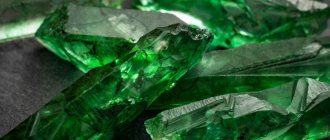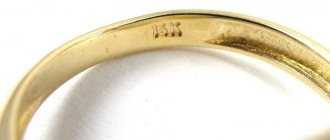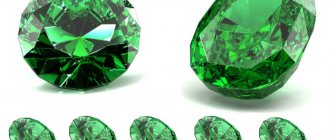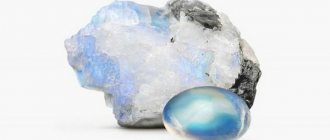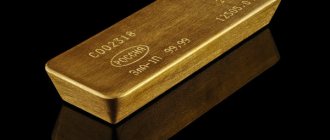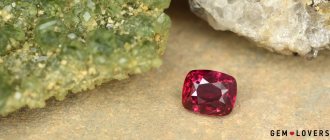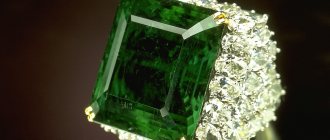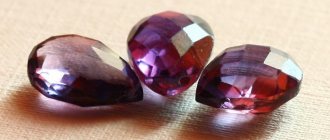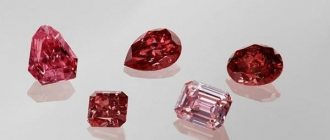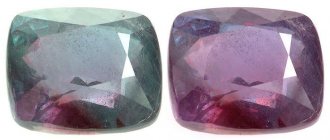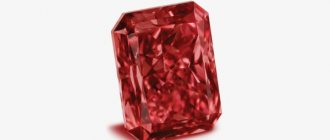| Stone type | Precious |
| Prevalence (Deposits) | Africa, Brazil, India, Colombia, Russia |
| Varieties | Brazilian, Zambian, Zimbabwean, Colombian, Ural |
| Transparency | Transparent, translucent |
| Shine | Glass |
| Mohs hardness scale | 7,5—8 |
| Chemical composition | Be3(Al,Cr)2Si6O18 |
| Color | Green |
| Owner's color type | Spring, autumn |
| Owner's temperament | Sanguine, phlegmatic |
| Names | Anastasia, Valeria, Vladimir, Gennady, Evgenia, Elena, Zinaida, Isabella, Inna, Lada, Nonna, Peter, Rostislav, Semyon, Timofey, Evelina, Yulia, Yuri |
| Zodiac sign | Libra, Aquarius, Virgo, Capricorn, Leo, Aries, Cancer, Pisces, Sagittarius, Taurus |
| Date of Birth | from June 22 to July 22 from February 19 to March 20 |
| Chinese horoscope | Bull, goat, rabbit, rooster |
| Element | Water, Air, Earth, Fire |
| Planet | Venus, Mercury |
| Day of the week | Friday |
| Month | January, April, June |
| Season | Spring, winter, summer |
| Numerology vibration | 5, 7, 22 |
| Chakra | Anahata |
| What stones is it compatible with? | Agate, alabaster, turquoise, white pearls, emerald, lapis lazuli, dark and blue sapphire, sardonyx, light topaz, chalcedony, amber, amber, jasper |
| What stones is it not compatible with? | Aquamarine, beryl, coral, moonstone, opal |
| Therapeutic effect (problems) | Blood pressure, insomnia, headaches, migraines, immunity, psoriasis |
| Therapeutic effect (on organs) | Organs of the gastrointestinal tract, joints |
| Magic properties | Strengthening relationships, finances, energy depletion |
Emerald is a precious and expensive mineral, so when purchasing, you need to be able to distinguish a natural stone from an artificial one.
The crystal belongs to the beryl group: in terms of external qualities and brilliance, it is not inferior to sapphires, diamonds and rubies. The stone is characterized by its green color and high transparency. The cost of 1 carat starts from 25,000 rubles. In this article, we will look at how to choose a real emerald, distinguish it from a fake, and list the most indicative experiments at home. Photos of emerald stones will help you make the right choice when purchasing.
What does a real stone look like?
Natural emeralds are highly prized by jewelers and collectors.
The appearance of natural stone attracts attention and fascinates. Main characteristics of emeralds:
- Color can vary from light green and dull grass to dark marsh. In the modern jewelry market, minerals that have a bright and deep color are rarer and have a high cost. Although previously, stones of a soft green tone were valued much higher.
- They are characterized by a translucent/transparent base, depending on the location of extraction and the quality of the stone. The shade of the mineral is noticeable in any lighting; when looking through it, you can clearly see the closing edge.
- Minor defects of various nature. Emeralds of ideal clarity are extremely rare and are the exception to the rule. Most minerals have small cracks - the difference lies in their size. For example, expensive mountain options have defects that are visible only with multiple magnifications. In lesser quality stones they can be seen with the naked eye. Even on high-quality crystals, light abrasions and minor scratches are acceptable (they indicate natural origin and not a damaged version).
- Interspersed with other minerals. They resemble small vessels and points on the body of the crystal. You can notice this feature only by illuminating the stone with a light source, examining the emerald under the sun's rays.
- Emerald crystals are highly durable (approximately 8 on the Mohs scale). At the same time, the mineral is quite fragile and unstable to mechanical stress. It should not be squeezed or heated - otherwise you may see the appearance of small cracks.
- In rare cases, air bubbles can be found inside emeralds, but such stones require additional jewelry testing (the risk of counterfeiting increases).
Emeralds are characterized by dichroism - when viewed in the light, their hue changes in the range from green to yellow, depending on the inclination and angle of incidence of the light.
Note! Natural green minerals have a high value. If a jewelry store offers you an emerald, the cost of which is less than 5,000 rubles per carat, it is a completely different stone or a synthetic analogue.
What parameters affect the cost of the original?
Factors influencing the pricing of a natural mineral are, first of all, the color, weight and size of the stone.
- The cost is influenced by the level of transparency, the quality of the cut and the degree of refinement of the gem.
- An important point is the mineral deposit.
- The best natural stones are mined in Colombia. Next on the value scale are gems from Russia and Africa, followed by Brazil and Asia.
- On the international market, prices are quoted exclusively in dollars.
- One carat is equal to approximately 0.2 grams.
- Large crystals sell for more.
What is offered under the guise of emerald?
Trade brands
Among the assortment of jewelry stores you can find many trade names that sellers may present as emeralds. Some products are labeled as varieties of a natural mineral - but this is not true. The buyer should be wary if he sees the following names:
- Evening emerald is a natural peridot that has a bright yellow hue. Under artificial light, it takes on a green color and looks no worse than its more expensive counterpart.
- Vilyui stone is an old name for brown vesuvian, which is not related to real emeralds.
- Oriental is a green variety of sapphires, which is inferior in price to emerald.
- Pakistani - garnet or agate of a light green hue with characteristic tints.
The listed stones are completely natural, but do not belong to the emerald class. Their cost is significantly lower, and the characteristics differ from the original green crystal.
Note! When purchasing jewelry with emeralds, you should carefully read the price tag and accompanying documents. Quite often, the real name of the stone according to the mineralogical nomenclature is indicated in small print. It is also worth checking the certificate of authenticity and finding out the origin of the selected gem.
Imitations
Emerald is a top-class stone with a great history and world fame. Therefore, some jewelers try to sell cheaper gems that are not precious, under the guise of a rare mineral. Analogs are characterized by a low price and pronounced brightness of color (natural emerald, in comparison, has a muted tint).
Be sure to watch: How a pearl forms and grows in a shell
As substitutes for emerald crystals you can find:
- demantoid is a fairly rare Ural mineral with a bright radiance and pronounced luster;
- prehnite is a derivative of calcium rocks and aluminum compounds, quite common in nature and does not have jewelry value;
- Tsavort is a mineral that has a bright green hue and sparkles noticeably in natural light;
- peridot or grossular - semi-precious stones that resemble expensive emeralds only in twilight or artificial lighting;
- Fluorite is a natural mineral whose inclusions resemble the appearance of rare Colombian emeralds.
Note! Quite often, substitute crystals are more expensive than the original gem (for example, an average emerald in terms of characteristics will cost less than an imitation made from dermatoid or jade).
How to understand that this is a real emerald? If you are an inquisitive customer and want to personally check the authenticity...
Published by Golden Gross / Golden Gross Monday, February 11, 2019
Doublets and triplets
An imitation of this nature is made by experienced jewelers, and the resemblance to the original will directly depend on the level of skill and professionalism of the author.
Doublets and triplets consist of successively connected plates in the form of natural stone. The following are used as separate plates:
- low grade natural minerals (cloudy stones)
- emerald fragments and other minerals that have little visual difference (beryl, quartz, etc.)
- various stones in combination with glass.
Several layers are connected using a special paste or adhesive base to match the stone. With magnification and good lighting, the joints inside the stone become clearly visible.
Synthetic stones
Counterfeits of natural emeralds have been around for a long time. However, the work of the craftsmen was of a primitive level and was easily identified by a jewelry maker. Since the end of the 19th century, the process of identifying a fake has become significantly more difficult. At this time, German scientists grew the first emerald in laboratory conditions.
Gradually, the quality of synthetic and natural stone reached the same level. For example, now both options cannot be distinguished by hardness and luminescence in ultraviolet light.
The main difference between artificial stone is its ideal structure without cracks and inclusions, which are characteristic of natural minerals. Also, the analogue does not change shade under sunlight and is resistant to severe mechanical damage.
Glass
The most popular option for counterfeiting emeralds is ordinary glass. The cost of such a basis is as low as possible, which guarantees high profits. Painted bottle glass is very fragile, but beginners can easily confuse it with natural stone.
Note! Air bubbles are often found inside glass counterfeits. Therefore, such a characteristic may be a sign of a fake stone in jewelry.
Historical reference
The upper class of Ancient Babylon considered gems to be a profitable investment. Queen Cleopatra of Egypt owned the mines. Archaeologists were able to discover inventory in abandoned mines located near Aswan. Their development took place under Pharaoh Sesostris III.
It should be noted that the minerals were mined in complete darkness.
It was believed that emeralds could be damaged by light.
To distinguish the crystals, the extracted stones were treated with olive oil. According to the Egyptians, green gems were a gift from the god Thoth.
Emerald is the talisman of Sultan Shah Jahan. It was he who became the creator of the Taj Mahal. Texts from sacred books were engraved on the gems. Subsequently, emerald began to be valued for its healing properties. With its help, they neutralized animal poison and improved vision. Alchemists believed that the occult principles for making the philosopher's stone were written on emerald tablets.
Residents of Central Asian countries wore the mineral as a protective amulet against evil spirits, terrible dreams and bad news. Emerald in gold was given to people suffering from ulcerative pathologies, epilepsy and heart disease. In Christian legends, the gem appears as a creature of evil and a hellish stone.
Emeralds were brought to Europe by sailors who visited America. This happened in the 16th century. In Rus', the gem was called emerald. He was considered a symbol of composure and hope. The development of the Ural deposits began in 1831.
What experiments will help you distinguish natural emerald at home?
Visual exploration
External examination of a faceted emerald or jewelry with such an insert is the simplest and most common way to determine the authenticity of a crystal.
Be sure to see: Where and how emeralds are mined
Using a standard jewelry loupe, you can determine the number and nature of inclusions inside the stone, the presence of cracks and air bubbles. Some jewelers can accurately determine the birthplace of a stone only based on visual research!
If the selected mineral is in a frame, then such a specimen must be viewed from a distance of at least 2 meters. A real emerald will differ from a fake by the absence of shimmer and excessive shine - the mountain crystal resembles dark green velvet.
A synthetically grown stone can be recognized by the specificity of its facets - they will be strictly parallel. At the same time, the growth lines are strictly ordered (while in natural stones they are located randomly and chaotically).
When examining a natural crystal, there should be no layering - therefore, any hint of it can indicate a doublet or triplet fake. The gluing between individual layers is best seen under bright sunlight.
Important! If you notice distinct layers inside the stone, and there are characteristic inclusions at the gluing points, this is a glass imitation. This option is one of the cheapest and least quality options.
Solid glass fakes are most easily recognized by their external qualities. These options are distinguished by their large sizes and excessive shine in any lighting. The edges of fakes look fuzzy and erased. You can also identify a fake by distinguishing the heating time - a natural stone will remain cool for a long time when in contact with human skin.
Published by Rina Bogaldina Friday, September 19, 2014
Ultraviolet
Using ultraviolet radiation, you can determine imitation stone or ordinary glass. In this case, the natural stone should have a brown-red, uniform shade. The absence of changes in color is a serious argument in favor of a fake.
Note! Other types of counterfeits are not detected by ultraviolet light, so this method cannot be the only verification option.
Water
One way to check the originality of an emerald is to immerse the selected stone in a container of clean water. If a red glow or slight reflection is clearly visible on the surface, this is a fake. In this case, a bright green outline on the water surface can be created by low-quality beryls with an emerald coating.
Also, the original stone should not fade or change color in water. If the background of the stone is pale, it is beryl, a yellow tint may indicate another mineral, peridot (in some cases, natural garnet). The presence of bright flashes of light indicates dispersion - in natural emerald it is extremely low (cubic zirconium may have reflections).
Hardness
The proven strength of natural emerald does not mean its resistance to damage and mechanical stress. By scratching the glass, you can damage the natural crystal - therefore, despite all its effectiveness, such an experience should not be used in practice. Counterfeits may be denser and damage the glass surface.
Problems with sample analysis
Checking the selected sample for originality requires minimal knowledge and auxiliary tools (for example, a magnifying glass, an ultraviolet lamp). However, experiments at home are characterized by some problems and difficulties:
- A natural crystal and a synthetic copy will have the same shade in ultraviolet light, so such a test does not exclude all types of fakes.
- When viewed under a magnifying glass, natural inclusions can easily be confused with layers and air bubbles in the glass. Such an inspection becomes difficult if the stone is small or has a setting.
Important! External analysis can fail a non-professional. For example, expensive and extremely rare Colombian emeralds have an unusual bluish tint. Due to their atypical color, even experienced jewelers can mistake them for an unskilled fake. For this reason, several originality tests should be carried out simultaneously to reduce the possibility of error.
One of the reliable indicators of originality is the refractive index of light. For natural stone it is 1.58, and for fake stone it is 1.55-1.57. Such a microscopic difference can only be recorded using a special device - a refractometer. This device is available only from jewelry makers and is not available for free sale.
other methods
It is good if the stone can be examined from all sides. But what if it is already enclosed in the decoration?
- Place the stone in a place that is well lit (you can point a lamp at it), move away a couple of meters and look at the stone from different angles. A real emerald will not have shimmer or shimmer - it will resemble green velvet.
- You can also detect a fake by comparing the package of documents provided and the price of the finished product. If the passport contains dubious words (for example, “evening” or “Pakistani” emerald), then with a 90% probability it is not an original stone.
- Another sign of a fake stone is the presence of a blue or blue tint, but only if the description in the documents does not mention that the gem comes from Colombia.
Main conclusions
Natural emerald is a rare stone with a fairly high cost. Such characteristics have made it a frequent target for counterfeiting. Fake stones can be found almost anywhere – even in large jewelry stores. For this reason, you should know how to distinguish an original from a fake of varying quality:
- natural stone has a green tint of varying saturation and moderate shine, its surface resembles velvet;
- upon contact with skin, the mineral must remain cool for a long time (the fake heats up quickly);
- When exposed to ultraviolet light, the stone acquires a brown tint.
When purchasing emerald jewelry, you should check the quality certificates. Natural stones always have a document of origin, which the seller must provide upon request.
Share your impressions of what you read and leave feedback in the comments.
Mining locations
Emerald deposits are located in Colombia, New Granada, and Zambia. Stones were also discovered in Italy, Pakistan, USA, Afghanistan, Russia, and South Africa. They are harvested in Madagascar, Tanzania, India, and Ethiopia.
Crystals are classified by quality. For example, stones from Norway, Ireland and Austria are classified as lower grade. In contrast, Brazilian and Zambian emeralds are at the highest level. The largest number of gems are mined from deposits located in Colombia.
Emeralds are the result of the action of magma on rocks located in the greisenization zone. A prerequisite is the presence of phlogopite mica. Thanks to the high temperature regime, the granite located under the initial layers turns into a mountain mineral. It contains mica, quartz and other types of ore.
Emeralds are also distinguished by color:
- Colombian - a shade of young grass. They are also characterized by a minimal amount of damage;
- Ural - cloudy, dark, rather large;
- Zambian - clean, rich green, transparent. There is often a blue or yellow tint present;
- Zimbabwean - yellow-green;
- Brazilian - yellowish, transparent, without impurities;
- South African - cloudy, light in color.
Trapiche emeralds are included in a separate category (example in the photo). They are decorated with a “wheel” with six spokes. The latter diverge from the center of the stone, forming rays.
External features
The mineral acquires a faint yellowish tint when the inclination of the sun's rays changes, but does not shimmer or cast reflections. A real emerald is neither orange, nor pink, nor blue; the stone is colored even green by chrome. Vanadium impurities give the crystals a bluish tint, while iron inclusions give a yellow tint.
Cracks or air bubbles, even in transparent stones, cannot be seen with the naked eye. The top of the crystals has a richer color than the base.
Reference! The most expensive stones resemble pieces of dark green velvet fabric.
Magic and astrology
Emerald is a powerful amulet that helps girls avoid fatal mistakes, makes them wiser and more feminine. In Kievan Rus, the gem was considered a talisman for women in labor and pregnant women. It gave them strength, made it easier to get closer to nature, and prevented complications afterward.
The nugget not only patronizes women, but also:
- activates prophetic dreams;
- protects the family from quarrels, mistrust and splits;
- gives strength and vigor;
- increases luck;
- inspires new achievements.
Emerald has a positive effect on the character of the wearer. It will be much easier for a person who chooses jewelry with this gem to cope with bad habits, get rid of aggression and internal contradictions.
The stone is suitable for people who have business acumen and creativity. However, it is not recommended to combine emerald with alexandrite, topaz, pearl, amethyst and opal. You should purchase products decorated with green crystals in the first days of the lunar cycle. This will ensure a more complete interaction with the stone.
The mineral is recommended to be worn by representatives of the following zodiac signs:
- Calf. In this case, the gem will give vivid impressions and emotions and help you concentrate on your goal;
- Cancer. The amulet will give you self-confidence and help you find true friends;
- Twins. The composure and wisdom of emerald will smooth out temper and aggression. As a result, the person will become more responsive and calmer. Communication problems will disappear.
Emeralds are contraindicated for Scorpios. People born under this sign should give preference to other stones.
Problems with sample analysis
Even knowing what a real emerald looks like, formed in the bowels of the earth, it is difficult to distinguish the stone from its artificial counterparts without special equipment. When growing hydrothermal crystals, conditions similar to those under which the mineral is formed in the natural environment are recreated. The basis of the gem is beryl, the color is given by chromium. Synthetic emerald is practically no different from natural stone:
- chemical composition;
- physical properties;
- crystal lattice.
To find the answer to the question of how to determine the authenticity of a gem, jewelers had to turn to gemologists.
Attention! During the study, scientists discovered that natural crystals are heavier than their analogues and do not luminesce under ultraviolet radiation. When processing natural stone, mirror cracks do not appear.
INTERESTING FACTS
- According to legend, the Queen of Sheba (the legendary ruler of the Arabian kingdom) preferred emerald to all other precious stones. Her best outfits were embroidered with emerald embroidery, on which more than 1000 maids worked.
- The National Bank of Tehran today houses a hairpin inlaid with three large emeralds that belonged to the founder of the Mughal Empire, the Great Mughal Babur. For many years it was used during the coronation of the Persian shahs.
- Emerald is considered the stone of fidelity, and according to one legend, this gemstone can break when one of the spouses of a loving couple is unfaithful.
- One of the legends says that the famous Holy Grail was made from an emerald that fell from the crown of the overthrown Satan.
- Ancient magicians believed that emerald could blind a snake and deprive it of its sight.
- The Roman historian Tacitus claimed that the emerald goblet, neutralizing the poison, more than once saved the life of Emperor Nero, whom they tried to poison.
- According to legend, emerald was the sacred stone of the legendary Atlanteans.
- In 1993, an emerald weighing 1200 grams was found at the Malyshevsky mine. It was named "President" in honor of Russian President Boris Yeltsin.
- The world's largest emerald crystal weighing 28 kilograms was found in Brazil in 1974.
- The first artificial emerald was grown in 1935 in Germany. Today, such synthetic gems are produced in many countries on an industrial scale.
HEALING PROPERTIES
Emerald has at its disposal an inexhaustible supply of healing and mystical functions. The unique properties of emerald have allowed people to use it for their benefit for thousands of years. It is believed that the mineral helps cure various ailments. The main “field” of its activity can be considered the stomach, bladder, head and joints. This stone is often used to purify drinking water: to purify one glass of liquid, you need to keep the mineral in it for at least 1 hour.
Lithotherapists claim that emerald stone can stabilize blood pressure and relieve both joint pain and headaches. The gem also treats inflammation of the bladder and stomach diseases. In ancient times, it was believed that the gem had the power to save a person from night blindness, eyesores, and epilepsy. Until now, many healers advise purchasing the mineral to get rid of nightmares. It is believed to be useful for insomnia and other disorders of sleep and wakefulness. In the old days, a stone was even hung at the head of the bed to protect oneself or children from nightmares and bad thoughts. Nowadays there is no such practice, but the belief remains.

